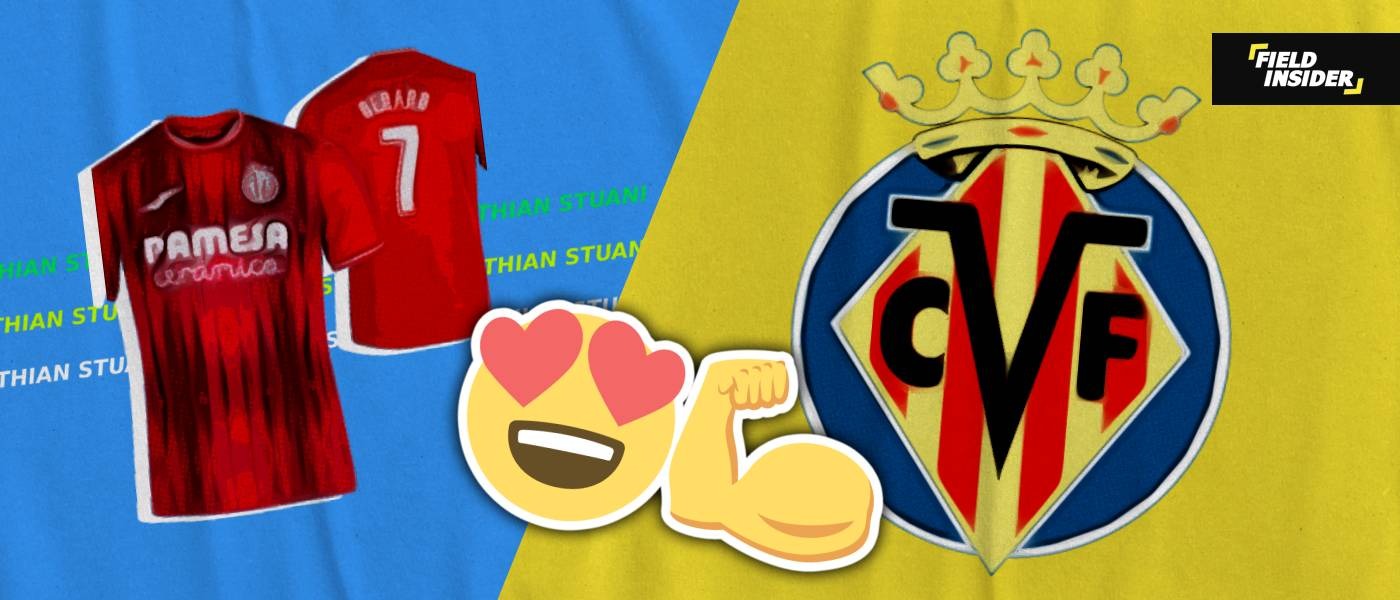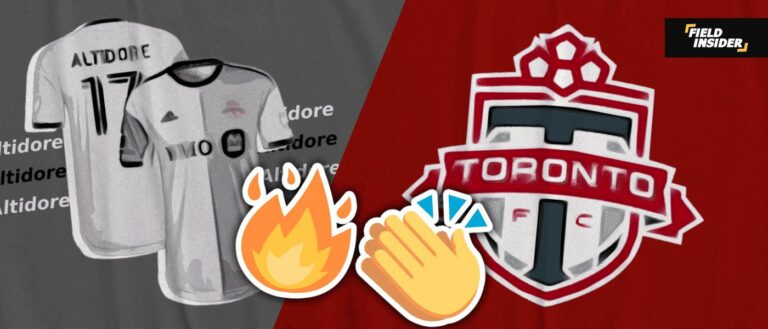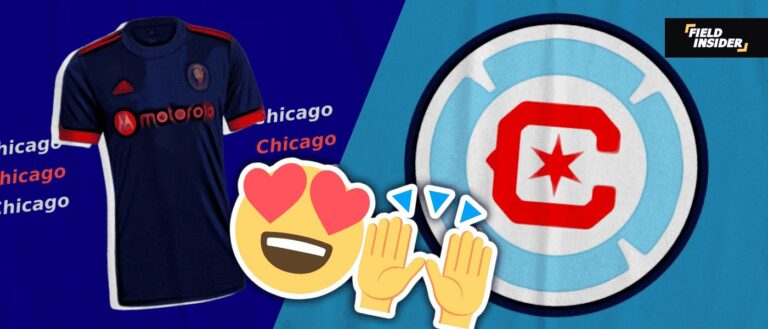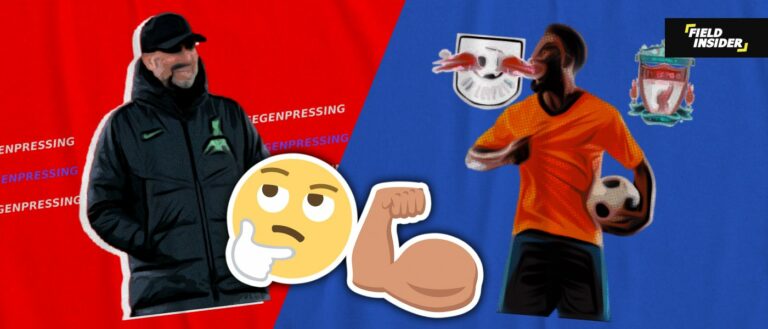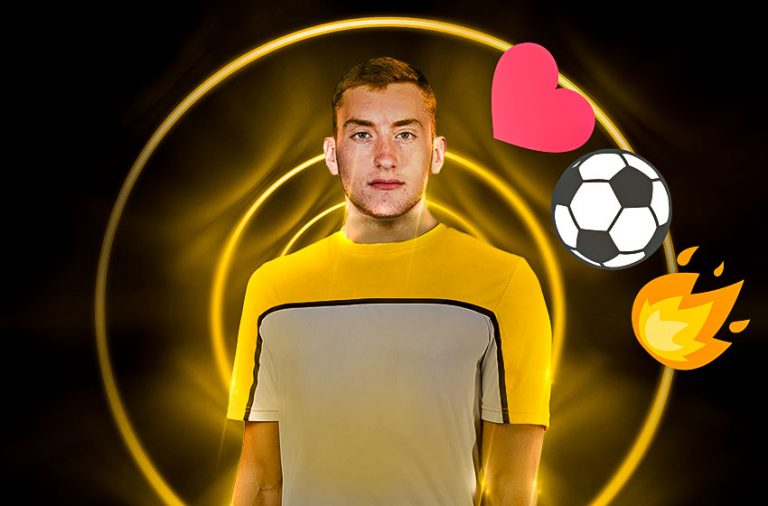Who Are Villarreal CF? History, Stats & More
Villarreal Club de Ftbol, commonly known as Villarreal CF, is a Spanish football club situated in Villarreal, Castellón province, eastern Spain. They compete in La Liga, the premier tier of Spanish football. Over the years, Villarreal CF has maintained a rich history.
Founded in 1923, the club ascended from the lower tiers of Spanish football and made its debut in La Liga in 1998. This rise is evidence that their journey has moved from humble beginnings to becoming one of the most prominent names in Spanish football.
As we are on the spree of covering all the major clubs from La Liga, Villarreal CF is our next stop. if you haven’t checked our coverage of other clubs, you can always head over to our soccer section and read about your favorite club!
Who Are Villarreal CF In La Liga?
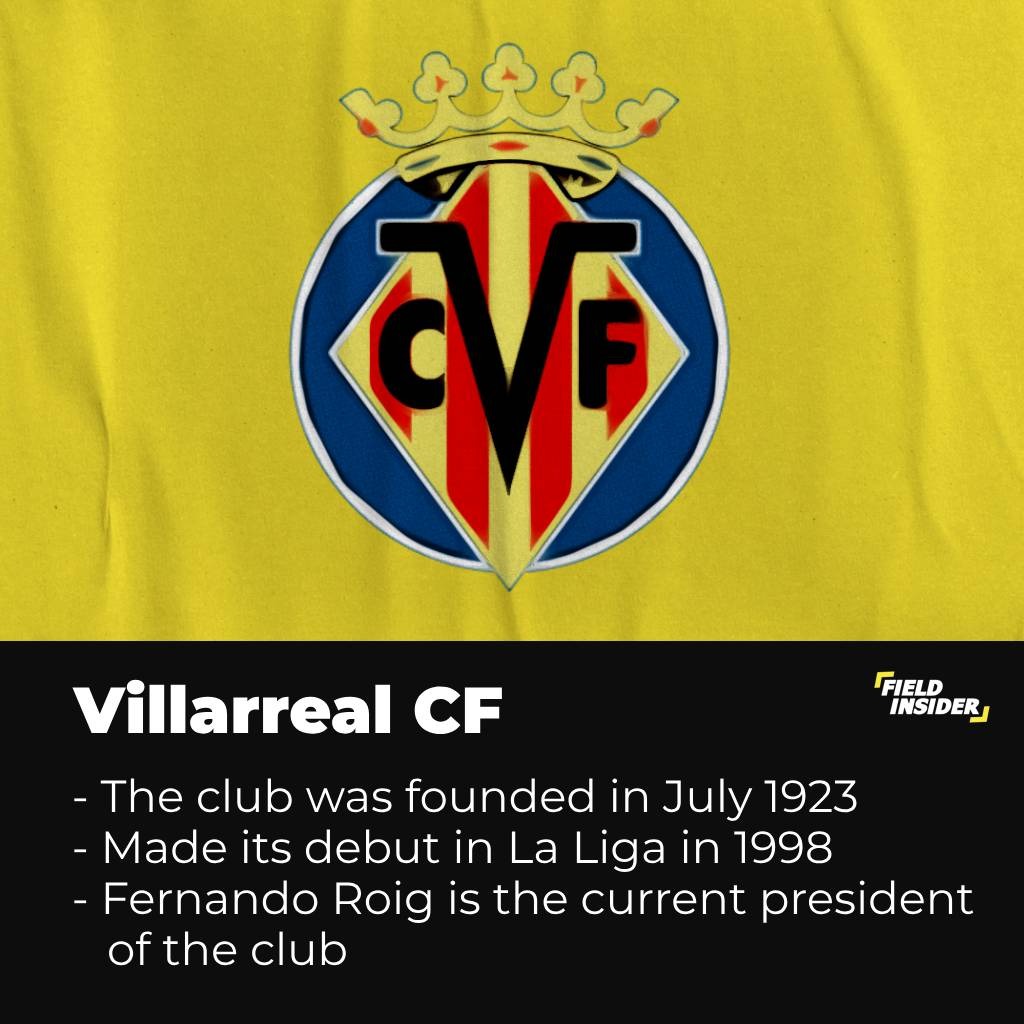
Villarreal CF is a Spanish football club hailing from Villarreal, Castellón province, in eastern Spain. Currently, they are one of the dominant teams in La Liga.
The club was founded in 1923 and it plied its trade navigating the lower tiers of Spanish football. In 1998, they finally made it to La Liga. Although they faced a setback with relegation in 2012, Villarreal CF have worked very hard to solidify their position in the league in the 21st century.
History Of Villarreal CF
Early years: 1923–29: early years
Villarreal Club de Fútbol (CF) found its roots in the year 1923 when it was established as Club Deportivo Villarreal. This nascent club was born on March 10th with a noble mission – “to promote all sports, especially Football”. The early days were characterized by modest arrangements.
Villarreal CF marked its first match on June 17th, 1923, locking horns with Castellón, a club that would become one of its enduring rivals. Later, on October 21st of the same year, Villarreal played their inaugural game against Castellón. At the outset, their kit featured white shirts paired with black shorts, a combination mirrored in their initial club badge.
1929-1998
In 1929, Villarreal CF entered regional competitions within the Spanish football structure. In the 1934–35 season, they came close to promotion to the nationwide Second Division but faced disappointment with a loss to Cartagena. The following season, they clinched victory in the First Division of the region but faced a new obstacle: the outbreak of the Spanish Civil War.
After the war’s conclusion in 1939, the club resumed play in the Second Division of the region. However, it wasn’t smooth sailing. In the early 1940s, CD Villarreal dissolved, making way for CA Foghetecaz, named after the club’s founders. By 1947, the new club joined the Valencian Football Federation, and in 1950, it became CAF Villarreal, with the ‘F’ symbolizing Foghetecaz. The final name change to Villarreal CF occurred in June 1954.
Their journey through the football tiers continued, marked by promotions and relegations. Notably, in 1997–98, they secured promotion to Segunda A by finishing fourth and winning a play-off against Compostela.
1998-2012
After stepping onto the grand stage of La Liga in 1998, Villarreal CF’s debut wasn’t a fairy tale. Following their rough start, they descended to the Segunda División for the 1999–2000 season. However, their tenacity paid off as they clinched the third position, earning them a swift return to Primera División.
Upon their return, Villarreal’s performance was inconsistent. After securing a seventh-place finish, they experienced two consecutive 15th-place seasons. Their European journey began with the UEFA Intertoto Cup in 2002, where they reached the final but lost to compatriots Málaga.
In 2003, they triumphed in the Intertoto Cup, earning a spot in the UEFA Cup. Their remarkable journey in European competitions started with a semi-final appearance in the UEFA Cup, only to bow out to eventual champions, Valencia.
Simultaneously, in La Liga, they secured an eighth-place finish in 2004 and marked another Intertoto Cup victory, leading to participation in the UEFA Cup. Though they reached the quarterfinals, Dutch side AZ ended their run. Their domestic performance, however, was stellar, securing a third-place finish in La Liga, which granted them entry to the Champions League.
In the Champions League, they overcame English Premier League’s Everton in a play-off and advanced to the last 16. Villarreal achieved remarkable feats, including drawing both games against Manchester United and proceeding to the quarter-finals. Unfortunately, they couldn’t reach the final, bowing out against Arsenal in the semi-finals.
In the 2008–09 UEFA Champions League, Villarreal made waves by holding Manchester United to a goalless draw and defeating Celtic. Their journey ended in the knockout stage against Arsenal.
Despite their domestic league position, they participated in the 2010–11 UEFA Europa League, reaching the semi-finals but losing to Porto, who later won the tournament.
After 2012
In 2012, Villarreal CF faced a significant setback when they were relegated from La Liga after a defeat to Atlético Madrid. However, their determination shone through as they returned to La Liga after a year in the Segunda División, where they finished second behind champions Elche. Their comeback was marked by an impressive start in the top flight, winning their first three games.
The 2013–14 season saw them secure a sixth-place finish, earning a spot in the Europa League for the next season. Continuing their solid performance, Villarreal secured a sixth-place finish in the 2014–15 season, granting them direct qualification to the Europa League group stage.
In the 2015–16 season, they briefly led La Liga before finishing fourth, advancing to the 2016–17 UEFA Champions League playoff round. They also reached the semi-finals of the 2015–16 Europa League but were eliminated by Liverpool.
Their success continued in the 2019–20 season, finishing fifth and earning a spot in the 2020–21 UEFA Europa League. In a thrilling final, they defeated Manchester United in a penalty shoot-out, claiming their first major trophy.
Due to this victory, Villarreal switched their participation in the 2021–22 UEFA Europa Conference League to the 2021–22 Champions League. In this campaign, they made it to the semi-finals but were defeated by Liverpool.
Despite challenges, Villarreal CF continued to make their mark in European football, showcasing resilience and determination. Initially, Villarreal CF was born from the dreams of a small group of Vila-real football enthusiasts on March 10, 1923, and started its journey as Club Deportivo Villarreal. Initially, they sported white shirts paired with black shorts, a far cry from the iconic all-yellow kits they adorn today.
The tumultuous backdrop of the Spanish Civil War led to a temporary disbandment of the football club, despite its earlier triumph in the First Division regional title. Rising from the ashes in 1942 as Club Atlético Foghetecaz, the club eventually settled on Villarreal CF in 1954.
The climb through Spanish football divisions was a rollercoaster, with promotions and relegations marking their path. In 1998, after 75 years since its inception, Villarreal CF finally scaled the summit, earning a spot in La Liga, the pinnacle of Spanish football. This achievement marked a historic milestone in the club’s remarkable journey.
How Was The Club Founded?
Villarreal CF’s journey began on March 10, 1923, when a passionate group of Vila-real locals established the club, initially naming it Club Deportivo Villarreal. Their early days saw them don white shirts and black shorts, a far cry from the distinctive all-yellow kit they proudly wear today.
The Spanish Civil War disrupted their progress, leading to a temporary disbandment despite their earlier success in clinching the First Division regional title. However, in 1942, they made a triumphant return under the name Club Atlético Foghetecaz, eventually embracing the enduring identity of Villarreal CF in 1954.
Nickname Of Villarreal CF: El Submarí Groguet or El Submarino Amarillo (Yellow Submarine) Béticos Fans & Culture Of Villarreal CF:
Villarreal CF boasts a devoted community-based fan base that played a vital role in the club’s survival during its toughest periods. This loyal support system, lauded by These Football Times, stood by the team during challenging times.
The club maintains strong ties with its local community through various initiatives. Notably, the ‘Villarreal CF Runners’, composed of supporters who share a passion for both soccer and athletics, enjoy discounts on local running race entries as season ticket holders.
Villarreal recognizes 29 official fan clubs, highlighting its commitment to fostering fan engagement. The Estadio de la Ceramica, the club’s modern home, stands on the same hallowed ground as its original 1923 stadium.
In the digital sphere, Villarreal is a standout La Liga presence on social media, with a diverse global following, including North America. Over the past year, the club’s social audience expanded by an impressive 52%, amassing a collective following of 6,743,364.
For Villarreal, the true value lies not just in numbers but in meaningful engagement, bridging the gap between the club and its community.
Major Achievements In The History Of The Club:

Villarreal CF has left its mark in domestic and European competitions over the years. In La Liga, they clinched the runners-up position in the 2007–08 season. On the domestic front, they achieved victory in the Tercera División in the 1969–70 campaign.
In European competitions, Villarreal showcased their prowess. They emerged as winners in the UEFA Europa League during the 2020–21 season, a significant milestone for the club. Additionally, they claimed victory in the UEFA Intertoto Cup in 2003 and 2004, cementing their reputation as a competitive force on the continent.
While they narrowly missed out on the UEFA Super Cup in 2021, these accomplishments underscore Villarreal CF’s rich history in football.
Notable Players & Record Breakers In The History Of Villarreal CF
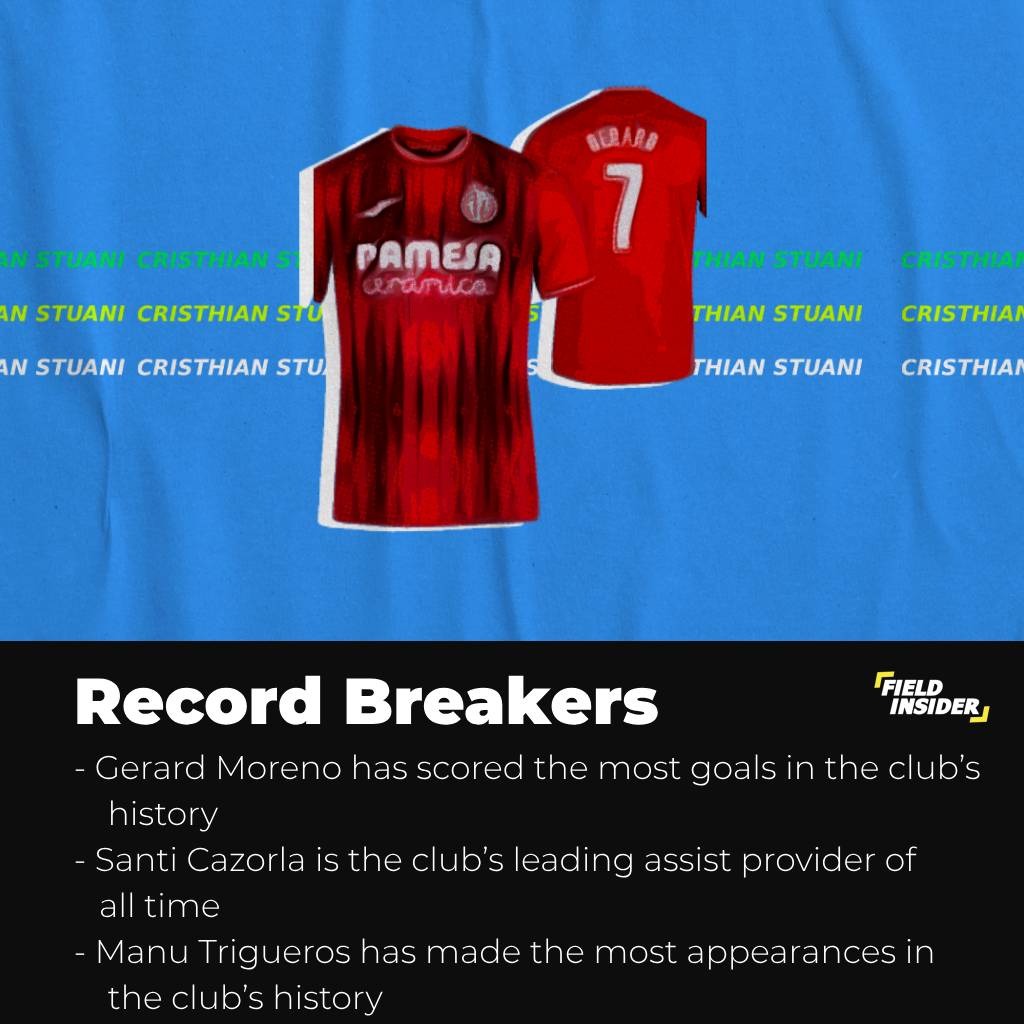
Top Goal Scorers for Villarreal
Safe to say that these players collectively reflect the rich history of goal-scoring talent that has defined CF Villarreal’s presence in Spanish football.
| Player | Goals Scored | Appearances |
|---|---|---|
| Gerard Moreno | 107 | 244 |
| Giuseppe Rossi | 82 | 192 |
| Diego Forlan | 59 | 126 |
| Santi Cazorla | 57 | 330 |
| Cedric Bakambu | 47 | 105 |
Top Assist-Providers for Villarreal
Santi Cazorla leads the list with 57 assists in 330 appearances, reflecting his creative playmaking abilities during his time at the club. Cani follows closely with 40 assists in 325 appearances, while Gerard Moreno, with 39 assists in 244 appearances, demonstrates his versatility as both a goal scorer and play maker.
| Player | Assists | Appearances |
|---|---|---|
| Santi Cazorla | 57 | 330 |
| Cani | 40 | 325 |
| Gerard Moreno | 39 | 244 |
| Manu Trigueros | 38 | 453 |
| Samuel Chukwueze | 31 | 207 |
Most Appearances for Villarreal
The provided data below showcases the top 5 players with the most appearances for CF Villarreal, underscoring their long-standing commitment to the club.
| Player | Appearances |
|---|---|
| Manu Trigueros | 453 |
| Bruno Soriano | 423 |
| Mario Gaspar | 421 |
| Marcos Senna | 360 |
| Santi Cazorla | 330 |

Home Of Villarreal CF: Estadio de la Cerámica
Nestled in the heart of Villarreal, Spain, Estadio de la Cerámica has been the hallowed ground of Villarreal CF since its inauguration in 1923. Formerly known as El Madrigal, this stadium stands as a testament to the club’s rich history.
This sporting arena boasts a capacity of 23,008 seats, a remarkable feat given that it’s nearly half the population of Villarreal itself. In Spain, it ranks as the 26th largest stadium and is the 5th largest within the Valencian Community.
The stadium witnessed its debut match on 17 June 1923, featuring Castellón and Cervantes. Originally named Campo del Villarreal, it was later rechristened to honor the very lands upon which it proudly stands.
Known affectionately as the Feudo Amarillo or “Yellow Fief”, it’s located at Plaza Labrador, 10 kilometers inland from the Mediterranean Sea, sitting at an altitude of 50 meters.
Estadio de la Cerámica has seen several transformations throughout its existence. In 1952, the pitch size expanded, matching the dimensions of the Helsinki Olympic Stadium. Subsequent decades brought covered stands, demolitions, and reconstruction. The latest renovations were completed in time for the club’s 75th anniversary, adding a grandstand enlargement and modern amenities.
On 8 January 2017, just before a La Liga match against Barcelona, the stadium’s name was changed from El Madrigal to Estadio de la Cerámica, a nod to the local ceramics industry, a testament to the club’s connection with the community.
Beyond its role as Villarreal CF’s home, Estadio de la Cerámica played host to Molde FK, a Norwegian club, for a Europa League match in February 2021, showcasing its significance on the international stage.
Estadio de la Cerámica is more than just a football pitch; it’s a symbol of Villarreal CF’s enduring legacy and its deep-rooted connection to its fans and the local community.
Rivalries Of Villarreal CF With Other Clubs
Villarreal CF has fostered a fierce rivalry with fellow local club Castellón. This geographic rivalry simmers with intensity, fueled by the pride of their shared region.
Beyond provincial contests, Villarreal’s competitive spirit extends to Valencia CF, their Valencian neighbors.
The battle between these two has earned the moniker “Derbi de la Comunitat” and is a hotly anticipated clash in the Valencian Community. The rivalry’s roots run deep, making these matchups an exhilarating spectacle for fans.


